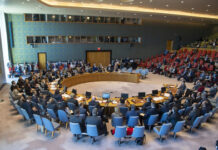Photo credit: DiasporaEngager (www.DiasporaEngager.com).
Results
Poliovirus Vaccination
In 2022, WHO recommended that all children worldwide be vaccinated against all polio types with ≥3 IPV doses (for countries using an IPV-only schedule) or ≥3 bOPV doses plus 2 IPV doses, in countries using a combined OPV-IPV schedule.¶ The estimated global RI coverage with ≥3 doses of IPV or OPV (Pol3) by age 12 months was 84% in 2022, compared with 81% in 2021 and 83% in 2020 (7). Coverage during 2020–2022 remained below the 85%–87% range reported annually during 2014–2019 (7), before COVID-19 pandemic–associated disruptions in RI programs. In 2022, estimated coverage with 1 full dose or 2 fractional doses of IPV (IPV1; one fifth of a full IPV dose administered intradermally) was 84%, an increase from 80% in 2020 and 2021 and above the pre–COVID-19 pandemic high of 83% in 2019 (7). In 2022, estimated national coverage with Pol3 and IPV1 was 76% and 71%, respectively, in Afghanistan and 85% and 90%, respectively, in Pakistan (7). Subnational administrative data indicate much lower RI polio vaccination coverage in WPV1 reservoir areas.
In 2023, a total of 119 SIAs were conducted in 30 countries worldwide. Approximately 675 million doses of bOPV were administered in 10 countries (including 114 million doses in Afghanistan and 264 million in Pakistan), 10 million doses of mOPV2 were administered in Sudan, 524 million doses of nOPV were administered in 24 countries, and 8 million doses of tOPV were administered in two countries (Somalia and Yemen). Although nOPV2 is the preferred vaccine for cVDPV2 outbreak response because it is more genetically stable than the Sabin strain in tOPV or mOPV2 (which is more likely than the nOPV2 strain to revert to neurovirulence), production by a single manufacturer has resulted in vaccine supply shortages.
Poliovirus Surveillance
Case-based surveillance for AFP in persons aged <15 years is the primary means for detecting WPV and cVDPV transmission. Environmental surveillance (ES), the testing of sewage samples for poliovirus, supplements AFP surveillance and can detect poliovirus circulation in the absence of AFP cases. Reported AFP cases are confirmed if poliovirus is isolated in a stool specimen at one of the 144 WHO-accredited laboratories in the Global Polio Laboratory Network (8). The two indicators used to monitor polio surveillance performance are the nonpolio AFP rate (a rate of two or more cases per 100,000 persons aged <15 years indicates sufficiently sensitive AFP surveillance) and stool adequacy (collection of two stool specimens of sufficient quality ≥24 hours apart and within 14 days of paralysis onset and received in good condition at a WHO-accredited laboratory via reverse cold chain for >80% of AFP cases). In 2023, eight** of 28 (29%) countries at high risk for poliovirus spread†† failed to meet global AFP surveillance indicator targets at the national level. In 2023, a total of 15,886 ES samples from 1,462 sites in 68 countries were tested, representing an increase from 14,498 samples (10% increase) from 1,117 sites (31% increase) in 69 countries in 2022.
Reported Poliovirus Cases and Isolations
Countries reporting WPV cases and isolations. In 2023, Afghanistan and Pakistan reported six WPV1 cases each, compared with two in Afghanistan and 20 in Pakistan in 2022 (Table 1) (Figure) (9,10). In Afghanistan, all six reported cases in 2023 were from Nangarhar province, and the two cases reported in 2022 were from Paktika and Kunar provinces. These three provinces are located along the country’s eastern border with Pakistan and have security challenges (9).
Four of the six 2023 WPV1 cases in Pakistan were from Khyber Pakhtunkhwa province, a northern province bordering Afghanistan, and two cases were from the southern Sindh province, specifically Karachi city. In 2022, WPV1 cases were confined to Khyber Pakhtunkhwa province, which is an area known for security and health access challenges (10).
In 2023, among 521 environmental samples tested for poliovirus from Afghanistan, 62 (12%) were positive for WPV1, compared with 22 of 698 (3%) samples tested in 2022 (Table 1). Whereas this finding represents a 25% decrease in the total number of samples tested from 2022 to 2023, the percentage that tested positive quadrupled. ES isolates were identified in eight provinces, including seven that did not report any WPV1 cases identified by AFP surveillance. Seven of the eight provinces with positive ES isolates were near the border with Pakistan.
In Pakistan, 124 of 2,202 (6%) environmental samples tested for poliovirus in 2023 were positive for WPV1, representing an 84% increase compared with those tested in 2022 (1,199), and a doubling of the 3% positivity rate (36 of 1,199) in 2022. These ES isolates came from five provinces covering most of the country, including three that did not report any WPV1 cases identified by AFP surveillance. Within Afghanistan and Pakistan, the number of provinces with WPV1 environmental isolates nearly doubled from seven in 2022 to 13 in 2023 (Table 2).
The 2021–2022 WPV1 outbreak in Africa included one WPV1 case in Malawi (November 2021) and eight cases in one province in Mozambique in 2022 (1). All Mozambique cases were genetically linked to the Malawi case and the Malawi case was linked to Pakistan. No WPV1 cases have been reported outside of Afghanistan and Pakistan since August 10, 2022.
Countries reporting cVDPV cases and isolations. The total number of cVDPV cases worldwide decreased 41% from 2022 (881 cases: 193 cVDPV1, 687 cVDPV2, and one cVDPV3 case) to 2023 (524 cases: 133 cVDPV1 and 391 cVDPV2) (Table 1), representing a 31% decrease in cVDPV1 cases and a 43% decrease in cVDPV2 cases. The Democratic Republic of the Congo and Mozambique each reported both cVDPV1 and cVDPV2 cases in 2022 and 2023. No country reported cVDPV3 in 2023, although one case was reported in Israel in 2022.
Although only 23 countries reported cVDPV polio cases in 2022 and 2023, active cVDPV outbreaks confirmed only through ES isolation were reported in an additional nine countries each year (Table 1). Among these 32 countries, eight§§ that reported cVDPVs in 2022 stopped their outbreaks and did not report cVDPVs in 2023. Among the 32 countries reporting cVDPVs in 2023,¶¶ eight countries*** that had not reported any cVDPV cases or isolates in 2022 had new outbreaks (Table 1) (Table 2). Despite completing planned outbreak response SIAs, 24 countries††† with cVDPV detections in 2022 failed to stop their outbreaks, indicating that enough children are persistently missed during the SIAs to sustain cVDPV transmission.
Source of original article: Centers for Disease Control and Prevention (CDC) / Morbidity and Mortality Weekly Report (MMWR) (tools.cdc.gov).
The content of this article does not necessarily reflect the views or opinion of Global Diaspora News (www.GlobalDiasporaNews.com).
To submit your press release: (https://www.GlobalDiasporaNews.com/pr).
To advertise on Global Diaspora News: (www.GlobalDiasporaNews.com/ads).
Sign up to Global Diaspora News newsletter (https://www.GlobalDiasporaNews.com/newsletter/) to start receiving updates and opportunities directly in your email inbox for free.































